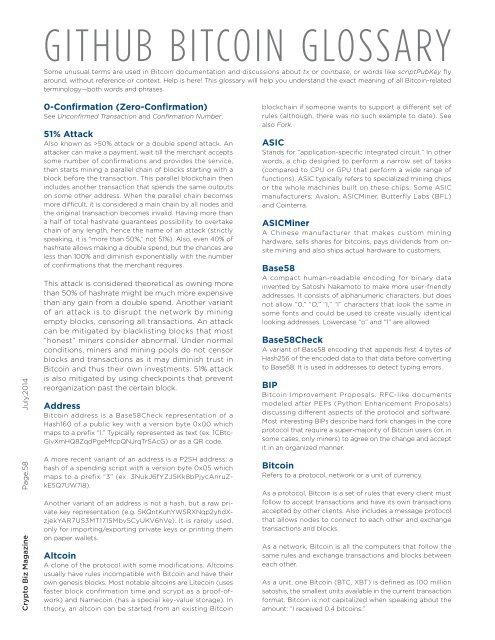Crypto Biz Magazine—July, 2014/Issue.02
Digital Currencies & Crypto Innovations—We observe and explore all aspects of the crypto world, including mining, financial trading, exchanges, development and business.
Digital Currencies & Crypto Innovations—We observe and explore all aspects of the crypto world, including mining, financial trading, exchanges, development and business.
Create successful ePaper yourself
Turn your PDF publications into a flip-book with our unique Google optimized e-Paper software.
GITHUB BITCOIN GLOSSARY<br />
Some unusual terms are used in Bitcoin documentation and discussions about tx or coinbase, or words like scriptPubKey fly<br />
around, without reference or context. Help is here! This glossary will help you understand the exact meaning of all Bitcoin-related<br />
terminology—both words and phrases.<br />
Page.58 July.<strong>2014</strong><br />
<strong>Crypto</strong> <strong>Biz</strong> Magazine<br />
0-Confirmation (Zero-Confirmation)<br />
See Unconfirmed Transaction and Confirmation Number.<br />
51% Attack<br />
Also known as >50% attack or a double spend attack. An<br />
attacker can make a payment, wait till the merchant accepts<br />
some number of confirmations and provides the service,<br />
then starts mining a parallel chain of blocks starting with a<br />
block before the transaction. This parallel blockchain then<br />
includes another transaction that spends the same outputs<br />
on some other address. When the parallel chain becomes<br />
more difficult, it is considered a main chain by all nodes and<br />
the original transaction becomes invalid. Having more than<br />
a half of total hashrate guarantees possibility to overtake<br />
chain of any length, hence the name of an attack (strictly<br />
speaking, it is “more than 50%,” not 51%). Also, even 40% of<br />
hashrate allows making a double spend, but the chances are<br />
less than 100% and diminish exponentially with the number<br />
of confirmations that the merchant requires.<br />
This attack is considered theoretical as owning more<br />
than 50% of hashrate might be much more expensive<br />
than any gain from a double spend. Another variant<br />
of an attack is to disrupt the network by mining<br />
empty blocks, censoring all transactions. An attack<br />
can be mitigated by blacklisting blocks that most<br />
“honest” miners consider abnormal. Under normal<br />
conditions, miners and mining pools do not censor<br />
blocks and transactions as it may diminish trust in<br />
Bitcoin and thus their own investments. 51% attack<br />
is also mitigated by using checkpoints that prevent<br />
reorganization past the certain block.<br />
Address<br />
Bitcoin address is a Base58Check representation of a<br />
Hash160 of a public key with a version byte 0x00 which<br />
maps to a prefix “1.” Typically represented as text (ex. 1CBtc-<br />
GivXmHQ8ZqdPgeMfcpQNJrqTrSAcG) or as a QR code.<br />
A more recent variant of an address is a P2SH address: a<br />
hash of a spending script with a version byte 0x05 which<br />
maps to a prefix “3” (ex. 3NukJ6fYZJ5Kk8bPjycAnruZkE5Q7UW7i8).<br />
Another variant of an address is not a hash, but a raw private<br />
key representation (e.g. 5KQntKuhYWSRXNqp2yhdXzjekYAR7US3MT1715Mbv5CyUKV6hVe).<br />
It is rarely used,<br />
only for importing/exporting private keys or printing them<br />
on paper wallets.<br />
Altcoin<br />
A clone of the protocol with some modifications. Altcoins<br />
usually have rules incompatible with Bitcoin and have their<br />
own genesis blocks. Most notable altcoins are Litecoin (uses<br />
faster block confirmation time and scrypt as a proof-ofwork)<br />
and Namecoin (has a special key-value storage). In<br />
theory, an altcoin can be started from an existing Bitcoin<br />
blockchain if someone wants to support a different set of<br />
rules (although, there was no such example to date). See<br />
also Fork.<br />
ASIC<br />
Stands for “application-specific integrated circuit.” In other<br />
words, a chip designed to perform a narrow set of tasks<br />
(compared to CPU or GPU that perform a wide range of<br />
functions). ASIC typically refers to specialized mining chips<br />
or the whole machines built on these chips. Some ASIC<br />
manufacturers: Avalon, ASICMiner, Butterfly Labs (BFL)<br />
and Cointerra.<br />
ASICMiner<br />
A Chinese manufacturer that makes custom mining<br />
hardware, sells shares for bitcoins, pays dividends from onsite<br />
mining and also ships actual hardware to customers.<br />
Base58<br />
A compact human-readable encoding for binary data<br />
invented by Satoshi Nakamoto to make more user-friendly<br />
addresses. It consists of alphanumeric characters, but does<br />
not allow “0,” “O,” “I,” “l” characters that look the same in<br />
some fonts and could be used to create visually identical<br />
looking addresses. Lowercase “o” and “1” are allowed.<br />
Base58Check<br />
A variant of Base58 encoding that appends first 4 bytes of<br />
Hash256 of the encoded data to that data before converting<br />
to Base58. It is used in addresses to detect typing errors.<br />
BIP<br />
Bitcoin Improvement Proposals. RFC-like documents<br />
modeled after PEPs (Python Enhancement Proposals)<br />
discussing different aspects of the protocol and software.<br />
Most interesting BIPs describe hard fork changes in the core<br />
protocol that require a super-majority of Bitcoin users (or, in<br />
some cases, only miners) to agree on the change and accept<br />
it in an organized manner.<br />
Bitcoin<br />
Refers to a protocol, network or a unit of currency.<br />
As a protocol, Bitcoin is a set of rules that every client must<br />
follow to accept transactions and have its own transactions<br />
accepted by other clients. Also includes a message protocol<br />
that allows nodes to connect to each other and exchange<br />
transactions and blocks.<br />
As a network, Bitcoin is all the computers that follow the<br />
same rules and exchange transactions and blocks between<br />
each other.<br />
As a unit, one Bitcoin (BTC, XBT) is defined as 100 million<br />
satoshis, the smallest units available in the current transaction<br />
format. Bitcoin is not capitalized when speaking about the<br />
amount: “I received 0.4 bitcoins.”


